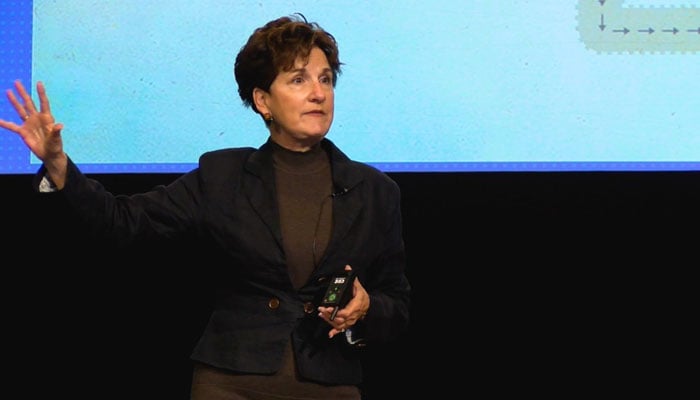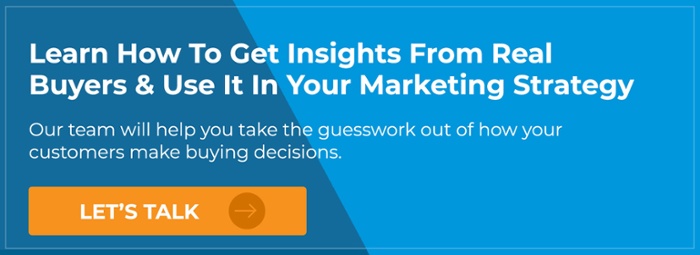
Companies Are Getting Buyer Personas Completely Wrong
Patrick Dodge
Founder
The most dangerous assumption you can make in business is thinking you know what motivates your customers to buy.
And yet, most businesses are doing exactly this with the buyer personas they use to base their marketing strategies on.
If you aren’t familiar, buyer personas are profiles representing people that influence the decision of whether or not to buy your product or service. That’s my simple definition.
But if you do a quick Google search for examples of personas, you will see profiles that include all kinds of generic information that serves no purpose to anyone, like education level, annual income, and hobbies.
How does a persona with insights like "has a bachelor's degree and wears multiple hats" help you sell a comprehensive B2B solution?
This subject drives Adele Revella absolutely crazy. She recognized years ago what many of us in marketing have long suspected. Companies are missing important insights about their buyer personas, causing them to waste money and even damage their brands. So she founded the Buyer Persona Institute, and created a revolutionary new approach to this critical research.
We were lucky enough to catch up with her to chat about her methodology, and how you can use them not only for lead generation, but also to improve customer experience as well.
Here is what she had to say:
Patrick: I discovered your work at just the right time. I remember hearing your podcast interview with Marcus Sheridan. He interviewed you about your approach to buyer personas, and, for me, it was like being struck by lightening. I immediately went home, bought your book, and it completely changed our approach to marketing.
Adele: Well thanks Patrick, I'm a trainer at heart. You know I owned a training business before this, so I really like to give people a lot of useful information. So I'm glad that my book launched you in the right path, and hope we can do that again today.
Patrick: Can you talk about the “Five Rings of Buying Insight,” and how you go about gathering them?
Adele: The key thing here is that we need to interview real buyers to understand what they think and care about from their buying experience. The typical way buyer personas are built with a template. There's a million of 'em out there. People either sit in a room and make stuff up about what goes in it, or maybe talk to the sales people and put stuff in the template. And/or some people will even go talk to a couple customers to fill in the info. But we need to get out of this whole template mode, and get out of building surveys, and stop asking questions about what we think is important.
Instead, we need to get real buyers on the phone, and have them tell a true story about a recent buying experience, and let the buyers run that interview. This is really the paradigm that's required, because as long as we're pushing our agenda, you know, "Did you see my campaign? Did you go to my website? What did you eat for breakfast?" We're not going to have learned anything about what the buyers think is important, and that's the objective.

So, let's talk about the five insight categories. We want to interview people who have actually made the buying decision that we need to influence. We want to let them tell their story, and we want to do that for 6, 8, 10 buyers. And then we want to go look for patterns across those interviews to answer the five critical needs categories that we have as marketers and salespeople.
First of all, we need to understand the Priority Initiative insight. What causes buyers to decide that today is the day that I've gotta go start looking for this solution? These are drivers. These are triggers. As marketers, one of the hardest things we do is get buyers to abandon the status quo, and decide to invest their time and budget to solve the problem. So that's one insight, we're looking for patterns across the interviews about those drivers.
The second category we call Success factors. These are the benefits or outcomes that buyers describe. As they tell their story about that real buying experience, they're going to naturally talk about these throughout the interview, and you want to mine the interviews for insights where people talked about the same kinds of outcomes, goals, and benefits.
The third category -- and this is the one that is generally the most overlooked inside companies that are living in their own echo chamber -- is what we call Perceived Barriers. This is where we look for patterns where people describe the same kinds of obstacles, or concerns, or objections, things that would prevent them from investing in our company. We highly recommend you interview some people who didn't choose your brand. You need to find out what those obstacles are.
The fourth category of insight, is called Decision Criteria. Again, this is another area that offers rich information for marketers. We want to understand all the capabilities that buyers were weighing as they went through the evaluation and compared their options. Buyers are so informed now, and they're getting their information from dubious sources sometimes, but they do have attitudes about the capabilities that they think are important. If we don't talk about those at their level of specificity and give them answers, they're going to choose someone else who does provide that information.
And the fifth set of patterns is what we call Buyer's Journey. Most people have done some kind of diagram of the buyer's journey. But what we're bringing from the interviews themselves is what buyers actually did as they went through this buying experience. The places they went, the resources they trusted, and the process they went through, as a team or individually, to come to a conclusion about which provider they think is best for them. And so now that journey is derived from verbatim quotes, as are all the insights, rather than pretty funnels.
Patrick: I think the quotes add credibility because you're not just sending out a survey and speculating on the answers. You're actually taking a passage from the interview and showing it to the client, and saying, "This is how our buyers actually articulate how they make decisions."
Adele: Exactly. I sometimes tell my team that we're in the quotes business. And its not about yes, no, answer A, B, C, or D. It's about -- and this is the skill involved in these interviews -- getting buyers to elaborate, "Oh, we wanted the product to be easy to use." Well great, what about it needed to be easy? How much training did you think you needed? Now you get the buyer's words getting into all that depth of detail, which you cannot get from any kind of survey.
My book is dedicated to every marketer who questions the wisdom of making stuff up. With a survey, if we write the questions and provide the answers, we only get some version of our truth. And we've got to forget about our version, we don't want to sit down and make this stuff up. We want to get people on the phone and ask one scripted question. “Take me back to the day when you first decided that you might possibly need a solution like this and tell me what happened.”
Then let the buyers run that interview. You ask only good follow up questions to get richer and deeper insight and quotes. Now your buyer's words are explaining their persona and their story.

Patrick: So how can marketers probe for these insights that will help them set the stage for the future customer experience, if they do become customers.
Adele: Well, there's two parts of this. First of all, if it's a fairly mature market, they're gonna be pretty educated about what the product does, and what they want it to do. If they've ever been through a purchase like this in the past, then they've already developed a set of expectations for that customer experience, or what happens after the purchase that's going to be absolutely embedded in their buying decision.
Since I’ve bought a car before, I now have a set of criteria for the purchase of my next car. I found it online and I called up the sales rep, and I said, "Do you have this car in this color with these features?" And I said, "Okay, I am driving to your dealership and I must be out of there inside of an hour. I cannot be there a moment longer than an hour." Now where does that come from? It comes from the other experiences I've had where I had to spend half a day sitting in the dealership dealing with all this back and forth. Insanity, right?
And then I also had expectations for how is the car is going to get serviced, that's all coming out of that interview because I've been a customer. Maybe I haven’t been to your dealership before, but I've been a customer in this category, and I'm gonna tell you what I want from that customer experience, because I'm using that criteria to evaluate who I'm going to do business with.
Patrick: So that's really interesting, When I ordinarily think about decision criteria and success factors, I'm thinking about features and benefits, and how the potential buyer is envisioning success after that purchase. But they may also be factoring in negative experiences that they've had, and including that in their criteria for the next go around when they look for a new solution.
Adele: Oh, times a hundred. I mean, we as buyers, as people, as human beings, we are much more concerned with what can go wrong than what can go right. And so when you're in these interviews, your buyers are absolutely going to talk at length. And if you're not getting those then you're not really getting your persona. I always say you do not want interviews with your best customers, because all you're going to get is happy talk. And that's not representative of a market full of buyers.
I go crazy every time I hear someone say, “Buyer personas are a fictional depiction of your ideal customer.” I’m like -- palm to forehead. The last thing we need is a fictional depiction of an ideal customer. I need a realistic depiction of a market full of customers because that's who I have to deal with as a marketer.
My ideal customer is gonna tell me that they think we're wonderful. I mean, sure they might have a few little issues here or there, but fundamentally these are people who chose us and want to feel good about that purchase. That's another part of the human condition. If we made this decision, we want it to have been the right decision. So we tend to focus on the positive, not the negative in retelling our story. But if we get people on the phone who didn't choose us, and who are candid with us, and we really get 'em to tell their whole story, they are absolutely going to talk about their fears and concerns. And that's what we most need to address as marketers.

Patrick: You bring up an important point here in terms of selecting people to interview. It's really easy to get people who love your brand to be willing to talk. But the last thing that's going to be useful to you is to listen to somebody sing your praises for a half an hour.
Adele: Yeah. There is an attitude that we have as marketers that only our happy customers will talk to us. I assure you that your unhappy customers want to talk to you even more than your happy customers.
Patrick: Marketers are starting to wake up to the fact that the customer experience doesn't begin and end with the sale. What are some ways people might use your methodology to gain insights about the post-sale experience? Do you have any thoughts about that?
Adele: Yeah, absolutely. People have asked us this. While I don't have the “five rings of customer experience” insights for post-sale, what you can derive from this is the concept of letting customers tell their story, especially any story that involves a decision. This method is most useful when you can get people to talk about a decision they made.
That decision might be a decision to use your product or service in a particular way. You might ask, “Take me back to the day when you first decided to have your car serviced at our dealership, rather than somewhere else.” Any place where there's a decision, where there's a defined beginning and end, this is a very good way to anchor people in a part of the story, and then let them walk you through that decision. Then you can come up with your own patterns across those interviews.
So the key is, no script, no structured questions, no multiple choice options based on what you want to know. Instead, give people a beginning point. "Take me back to the day when it was your first day after you began to implement this and tell me what happened." Then have people walk you through that experience from their perspective. And your only agenda, getting them to go deeper and deeper on everything they tell you. That's the real skill in the we work with our interviewers. We tell them, think more like a journalist than a researcher. A good journalist goes with an area of where they want to explore, but the questions are posed from something somebody just said, rather than everything they wrote on their notepad ahead of time. Do that with your buyers.
Patrick: Exactly. Thinking again about the post-sale, maybe it could be, "Think back to the first time when you had to reach out to customer support. Why did that happen?"
Adele: There you go.
Patrick: Yeah, "Why did you have to do that, and what was your experience like? We're you happy?"
Adele: Yep. That's a decision. Then get people to back up from that decision, because we give people a starting point, and then we back them up because we want to understand what preceded that decision. Then we want to know what came after. So don't forget to get what preceded that, because people tend to start with the action rather than like, "Okay I called customer support," and what you really want to know is what were all the things they tried before they called customer support. "Okay so great, you called customer support because blah blah blah. I want to go back to what you did earlier than that." Because we're trying to get inside their thinking about that decision, and we can't just let them go too quickly through what happened after. We want to find out what happened before.
Patrick: So you really want to be talking to the person who's most invested in this decision. The person who's been tasked with doing the research, finding the best options, and then putting forward a recommendation to the senior leadership, or whoever's ultimately making that decision.
Adele: There are some cases where we want to talk to the economic buyer, particularly if we're in a market where our goal as a marketing team is to drive more investment in our category. Then we want to talk to that economic buyer to see what we can learn about why they aren't investing as much, and what we need to do. But if we're going to get all five rings of insight I described earlier, we want to talk to that lead evaluator.
Patrick: What are some of the new trends that the Buyer Persona Institute is working on now? What can we expect to learn about next year?
Adele: Sales enablement.
Patrick: Alright!
Adele: Yeah, not ready to talk about this in detail yet Patrick. So first of all we figured out a few years ago that it isn't enough to build personas. We need to then help our clients build value propositions. So we have a phase two of every engagement, where we do a workshop and help our clients. It's a really simple Venn diagram, you can picture this in your head. Two overlapping circles. On the left we've now learned everything buyers want from this buying experience. And on the right is everything you guys could possibly deliver in the buying experience. And now we have this really wonderful sweet spot in the middle where what we deliver, and what buyers want is magically aligned. That's like a workshop we've been doing for years. Very, very critical. Because otherwise people kind of go, "Oh wow, they got great personas, great quotes, great insights," and then nothing changes.
Now in 2019, we will be using these insights to drive sales training, to drive sales enablement, and help salespeople understand what buyers want from the buying experience. At some point there's a salesperson involved. And what we know from thousands of interviews with real buyers, that what happens once that sales rep gets involved has everything to do with whether or not the company wins that business. So we're going to take that on next year.
Patrick: This is fantastic stuff. Thank you so much. How could people learn more about you?
Adele: Well it's really easy, we're at buyerpersona.com. And also on Facebook at, it's still Buyer Persona. I'm on Twitter @buyerpersona. We're on LinkedIn, can connect with me directly, Adele Revella. Or you can connect with the company, Buyer Persona Institute through LinkedIn. Lots of ways, if you insert buyer persona, we should show up.
Patrick: You do. I've tried it.
Adele: I'll tell our SEO guy it's working.
Patrick: That's right. Adele, thank you so much for joining us today.
Adele: Well thank you for having me Patrick, it's my favorite topic, and I appreciate the opportunity to talk about it.
Jan 5, 2019 10:07:48 AM
